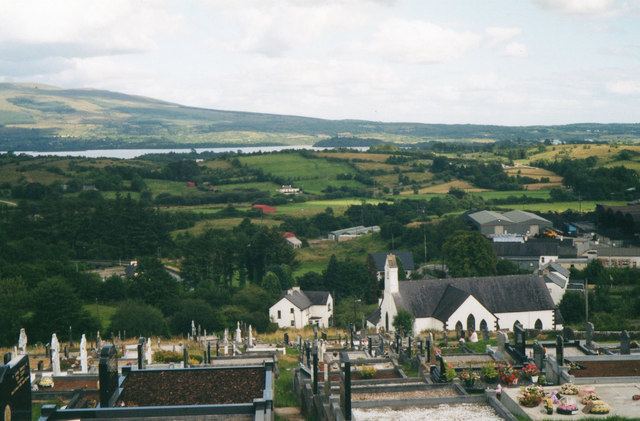Time zone WET (UTC+0) Elevation 86 m | Irish Grid Reference G931142 Local time Wednesday 7:52 AM | |
 | ||
Weather 2°C, Wind SW at 8 km/h, 90% Humidity | ||
Arigna (Irish: An Airgnigh [ˈan̪ˠˈaɾʲɟnʲiː], formerly Arigneach) is a village in County Roscommon, Ireland. It is near Lough Allen (on the Shannon-Erne Waterway), on a designated "scenic route" between Keadue and Slieve Anierin. Arigna is situated in Kilronan Parish alongside the fellow picturesque villages of Keadue and Ballyfarnon. The village lies close to the shores of Lough Allen.
Contents
- Map of Arigna Co Roscommon Ireland
- Arigna coal mining
- Life inside the Mines
- Transport
- Notable people from Arigna
- References
Map of Arigna, Co. Roscommon, Ireland
The village has a long association with the mining industry. Mining was carried out in Arigna for over 400 years until the mines were shut in 1990.
Arigna coal mining
The Arigna Coal Mine is famous for its very shallow deposits. Seams of culm were worked by miners lying on their sides to shovel the coal out. Mining lasted until 1990, and the coal was used for iron works and later for a power plant. With the demolition of the ESB Generating Station chimney, the era of collieries in the area ended.
The mining history at Arigna started in the Middle Ages with the mining of iron. East of Lough Allen lies a mountain called Sliabh an Iarainn, which translates into the English language as Iron Mountain. At the beginning of the 17th century, the iron was smelted at Arigna in new built iron works, using charcoal, which was burnt from the wood of the forests around. But as no organised tree planting took place and the timber eventually ran out, the iron works had to be closed at the end of the 17th century. More than half a century later, in 1765, the mining of the coal deposits started, and again 30 years later the smelting was revived using the local coal instead of charcoal. This iron works closed finally in 1838, as they were not very successful.
Coal mining continued and provided work for the people in the area. The coal was used to heat homes and hospitals, and to power steam engines. In 1958 the Arigna Power Station was opened to produce electricity. It was the first major power generating station in Connaught. The station was built specifically to burn the semi bituminous coal with its high ash content. At its height, the power station burned 55,000 tonnes of coal per year and employed 60 people. Like in other coal mining areas of Europe, the main goal of this power station was to secure the jobs in the local mining industry. During the internationalization process of the mid-20th century, foreign coal from much bigger and easier to mine deposits became much cheaper than local coal. At the end of the 1980s, the power station was shut down, and without its main buyer the mine closed in 1990.
Because of the thin coal seams, a special type of mining was practised at Arigna. A main tunnel was driven from which branched a series of secondary tunnels every 5–6 meters, where the coal was mined. The secondary tunnels followed the seams and were rather low. The miners typically worked lying on their back to cut the coal. These 'Cutters' or 'Brushers' also prepared the mine for the next days work, and extended the roads using explosives. 'Drawers' filled hutches (tubs) and pushed them out to the main underground mine road. Here the hutches were linked up to an endless-rope haulage system and were pulled to the outside. Sometimes small diesel locomotives were used to pull hutches out of the pit. 'Proppers' used timber pillars to prop up the mine roof.
The Arigna Mining Experience consists of an exhibition and an optional underground tour. The underground tour is guided by former miners, who are able to answer many questions on the coal mining process. This tour is a little difficult, as the mine is often very low. Visitor get hard hats to protect their heads. Lighting and sound effects throughout the mine are intended to add to the authenticity of the experience.
In April 2009, a musical celebration of Arigna's mining heritage, Scars On the Mountain was launched by RTÉ, Ireland's state broadcaster.
Life inside the Mines
In his memoir, The Home Place, author Brian Leyden gives a vivid description of life in the mines.
In the following passage, Leyden describes the conditions in which the miners worked: "The coal mines were often tiny by the standard of most industrialised countries. The men often had to lie on their backs in water, using a handpick or short-handled shovel to get at a thin seam of coal under a ledge of rock."
Life as a miner was not for the faint of heart, as the next passage illustrates; "At the pit entrance a red light burned at a picture of the Sacred Heart. The coal-miners blessed themselves at this spot before they went underground. Strangers who visited the mines out of curiosity often found the experience of the mineshaft so frightening they never got past the picture."
Being down in the mines must have seemed like being in another world. The surroundings were very different from the world outside and the miners even had their own language; "You never saw a 'styme' of daylight from the time you went underground that morning until you surfaced again that evening. They spoke an underground language of 'sumps' and 'gobs', 'hutches' and 'clips', 'bings' of slate and 'bullets' of rock, 'caps' for detonating 'spats' of dynamite."
Transport
Arigna railway station opened on 2 May 1888, but finally closed on 1 April 1959. It was part of the narrow gauge Cavan and Leitrim Railway.
